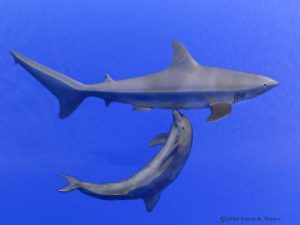
In this week’s science spotlight, we thought we would take a moment to dispel a few common dolphin myths. Given the popularity that dolphins enjoy, it is certainly understandable that at least some of the information available in the media, the internet and from the minds of our fellow human beings is not always scientifically sound. Here are 5 commonly heard myths concerning dolphins.
Number 3) Dolphins are one of the only animals to have sex for pleasure
This particular myth tends to pop up with regularity in conversation whenever the subject turns to sex. Even the writers at the ever vigilant snopes.com l end credence to this particular myth. The problem here is that volumes could be (and have been) written on the definition of sexual behavior in animals and the description of pleasure. It isn’t enough to simply go by the dictum that animals have sex to reproduce and therefore any sexual act occurring at times when egg fertilization is impossible must then be understood as occurring for reasons other than reproduction. The truth here is that animals almost never engage in a sexual act with the specific intent of producing offspring; during ovulation or otherwise. It is more accurate to state that animals (including humans and dolphins) are often driven to engage in sexual acts because the act itself is rewarding – it stimulates pleasure centers in the brain through the release of endorphins or other pleasure-inducing brain cocktails. The ultimate cause of this behavior is reproduction, but the proximate cause can be any combination of stimuli that happen to be present at the moment; pheromones, visual stimuli, etc. Occasionally these sexual acts occur at times when the female is not fertile, but it’s not a fertility-state that should be the litmus test for sexual pleasure – it should be the pleasure itself. So if you happen to spot two dung beetles engaged in a lengthy sexual act, you should still be able to state they these beetles are making whoopee for the sheer pleasure of the act itself. Who’s to say dung beetles don’t enjoy sex as much as humans do? Furthermore, what you and I might call a sexual act might be nothing of the kind for an animal like a dolphin. Dolphins often engage in forceful mounting behaviors involving erections that clearly do not involve reproduction, and in fact look more like social dominance or simple aggression. Is it fair to label this as sex for pleasure? Not really. It seems that the scope of the problem here is far too great to simply be summed up in a simple statement to the effect that dolphins engage in sex for pleasure and other animals do not. If it were this simple, we should all have great difficulty explaining why the neighbor’s poodle habitually mounts your leg whenever you pop over for a visit.
Number 4) You will never find sharks where you find dolphins
Sharks and dolphins are not friends. That is not a secret. The wild dolphins that we study in the Bahamas and Japan are covered in bite marks attesting to a lifetime of close-calls involving hungry sharks. Young calves are especially vulnerable to shark attacks, with many newborns not surviving their first year. Dolphins, like many other animals in the ocean, are constantly on the lookout for sharks, and they are doing their utmost to avoid any potentially lethal encounters. But it would be unwise to assume that the presence of dolphins means that they have managed to elude all sharks in the area, and that it is safe to go in the water. After all, if dolphins were able to avoid shark attacks 100% of the time, why are so many of them covered in shark bites?
Number 5) Dolphins have their own language
This particular topic was covered at length in a previous podcast episode titled Do Dolphins Have a Language? The short and sweet answer to this question is No – they don’t have a language. For the long and equally as sweet answer, check out the episode.
